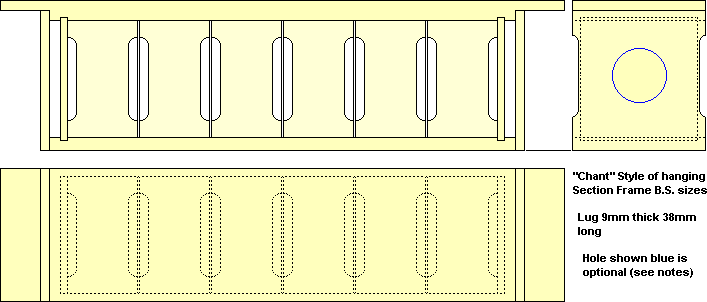A hanging section frame that has the sections running crossways instead of inline.
This is a design that I have put together as a result of information from Madeleine Pym about a hanging section frame found by her father, Ernest Chant, in a museum at Eilff (10 Km from Liege). The idea struck me as a good one and, as a result, I offer this design so that others may try it.

The six sections are separated using square pieces cut from Thorne's plastic section dividers. The whole assembly is tightened by fitting extra separators or thin wedges.
The original and Ernest's example did not have dividers. If you wish to try it this way you should increase the 'Sides' in thickness to suit (I will probably try this by placing all my dividers to one end of the stack).
If you only require a few sections or just want to try because you have not done it before, then this is an excellent method of achieving either of those aims.
At the time of originally writing this page (August 2000) I had not tried this system, but it looks fairly promising... Dimensions may be 'adjusted' later, (if required), in the light of actual experience.
I offer this design so that others may try it. My version is made from six pieces of waterproof plywood
| Qty | Length | Width | Thickness |
|---|---|---|---|
| 1 | 432 mm | 125 mm | 18 mm |
| 1 | 338 mm | 125 mm | 12 mm |
| 2 | 131 mm | 125 mm | 9 mm |
| 2 | 116 mm | 110 mm | 6 mm |
There may be some advantage in hole sawing a 32 mm or 38 mm hole, centrally, in the outer end plates.
There are two reasons for this...
No1, It improves bee flow into the Killion space and...
No2, If any brace comb is built within the hole it would indicate that the bees were too cramped.
The inner shields are rebated into top and bottom bars by 3 mm.
If several of these frames were to be used side by side then the top and bottom pieces should have scalloped edges to allow for bee entry from above and below. Alternatively the bottom bar can be made 112 mm wide instead of 125 mm which will allow bees access from below.